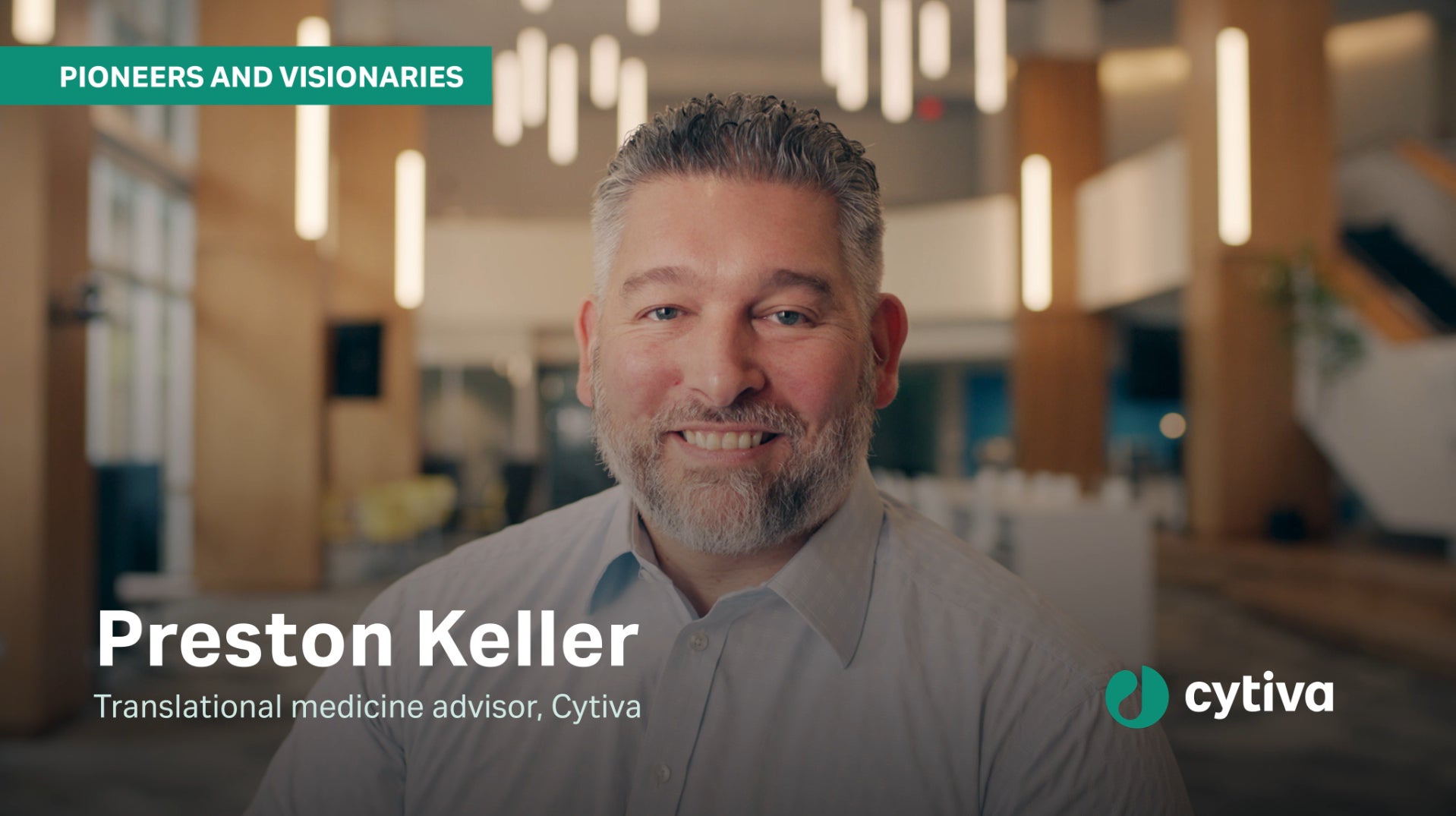
Keller says the first time he saw Star Wars, he realized what he wanted to do ― use science to improve lives.
“Luke Skywalker had a biomechanical hand,” he says. “I was just fascinated with human biology and pursued the path to be a scientist.”
Keller is now the translational medicine commercial leader at Cytiva, working to build out its translational research proposition and engage with the unique needs of scientists. In short, the team hopes to help researchers turn their innovative findings into new, beneficial therapies.
He explains: “Translational medicine is the study of the process of moving discovery to practice to clinics. Clinical trials are conducted to demonstrate the safety and efficacy of new therapies in patients for a specific disease indication.
“Startup companies are working to commercialize early-stage (preclinical) therapies and move them, as quickly and safely as possible, into clinical trials where we can find out what, if any, impact these new treatments will have on a patient’s quality of life.”
Bridging the ‘Valley of Death’
A recent report by the Congressional Budget Office, Research and Development in the Pharmaceutical Industry[i], concluded that only about 12% of drugs entering clinical trials are approved for clinical use by the Food and Drug Administration (FDA).
According to the report, estimates of the average R&D cost per new drug range from less than $1 billion to more than $2 billion per drug. These costs include expenditures on drugs that do not make it past the laboratory-development stage, and also those that enter clinical trials but fail in those trials, are withdrawn, or are not approved. These estimates include costs incurred during preclinical studies, which make up a substantial share of the total cost of developing new medicines.
The conventional discovery and development process for new medicines can impede the conversion of fundamental research into useful medical products and devices, due to the rigid linear path of traditional technology transfer models.[ii] Considered by many academics as outdated, this approach fails to account for the nuances and complexities that characterize current ongoing university commercialization activities leading to oversimplification and a one-size-fits-all approach.
This failure to bridge the gap between preclinical and clinical research, is known as the ‘Valley of Death,’[iii] and alludes to the majority of projects that fail in their attempt to move from scientific potential to medical reality.
Understanding the cause of these failures, and providing solutions is the objective of scientists and suppliers like Cytiva.
A supplier of tools and services for manufacturing therapeutics, Cytiva aims to understand the causes of failures in various fields — including biological research, vaccine development, biologic drugs, and cell and gene therapies — and collaborate with academia and industry to provide solutions that improve patient outcomes.
Challenges to developing new therapies: Challenges in the translational space were highlighted in a recent survey by The Translational Scientist [iv], which identified five common roadblocks respondents experienced on the journey from preclinical research to commercialization, and how scientists perceived them. According to this research, the main barriers in translational medicine are:
1. Knowledge gaps between discovery and commercialization
Translational researchers don’t always feel at ease transitioning from the bench to business, resulting in a low rate of success in translating promising breakthroughs to new medicines. Changes in organization structures, better funding incentives, and close collaborations between academia and industry are necessary to propel translational research toward clinical trials.
2. Navigating the regulatory approval process
Gaining regulatory approval is rigorous and complex, necessitating good documentation practices and quality standards. Knowing what regulators require is crucial for human trial clearance and market approval.
3. Building a robust, scalable workflow
Transitioning from manual processes to robust, scalable workflows requires time, effort, and investment. Access to innovative solutions and experienced partners across the industry is vital for successful translational research, especially when navigating a rapidly evolving regulatory landscape and dealing with cutting-edge medicines, such as cellular therapies.
4. Managing and analyzing data
Detailed documentation of chemistry, manufacturing, and controls (CMC) data ensures high quality products for patient administration. Accurate data and robust analytical capabilities help to move translational research forward to clinical trials, but both can be challenging to access without an automated documentation system.
5. Accessing talent and expertise
Building a translational team with the necessary biopharma expertise is crucial for clinical research, clinical trials, and advancing emerging therapies. Finding diverse talent with the right knowledge, skills, and experience ― along with life science suppliers that can create customized solutions ― is essential, yet also challenging.
Choosing an experienced collaborator to support your journey
According to Keller, addressing these challenges is all part of the translational medicine process.
“You need to consider things that you might not have considered as a scientist before,” he says. “You need to think about your intellectual property position and what mechanisms you have for funding. You also need to think about your regulatory roadmap, good manufacturing practice and manufacturing concerns. How are you going to make this product safely and at scale, so that you can administer it to a human being?”
That is where a firm like Cytiva comes in, Keller says.
The company is taking on the challenges identified from The Translational Scientist survey and teaming up with innovators to help them break new scientific grounds and achieve every milestone in the development of new therapies. Cytiva provides robust equipment and workflows and supports necessary training for research staff, aligning resources to collaborate across the entire translational ecosystem.
The support does not stop with clinical trials. Once your therapeutic reaches early-stage trials, you still want to be ready to scale up into phase two and ultimately into phase three, Keller points out.
“We are right there with you, as a multidisciplinary member of your team, bringing knowledge and solutions when needed most. We assist you to scale-up as quickly and economically as possible, so you can concentrate on what the business aspect of developing a therapy is going to look like, as well as the science, when you move forward,” he adds.
Why collaboration is important
“You’re now dealing with an entirely different level of complexity with these new biological therapeutics, so you really need an invested partner,” Keller says.
He points out the important relationship among academic translational centers (innovation), big pharma companies (pharmaceutical expertise), and tool and reagent providers, who can build bridges to advance these new biological therapies into the clinic.
Being able to support people and bring emerging therapies from the discovery phase to regulatory approval will have a meaningful impact on some of the world’s most devastating diseases, notes Keller.
“My role in all of this is so small compared to those that are on the frontline every day, but the work that I’m doing with Cytiva can help in terms of moving these technologies on further and getting these drugs into a patient that much faster,” concludes Keller. “Sometimes a matter of days is all the difference in the world.”
Click on the link below to watch Preston Keller explain the challenges of translational science and detail the state-of-the-art solutions that are available to help overcome common roadblocks.
[i] https://www.cbo.gov/publication/57126
[ii] https://cord.asu.edu/sites/default/files/wp-content/uploads/2015/02/models-and-methods-of-university-technology-transfer.pdf
[iii] https://www.ncbi.nlm.nih.gov/pmc/articles/PMC8504824/
[iv] https://www.cytivalifesciences.com/en/us/news-center/5-translational-research-challenges-on-the-path-to-patients-10001



